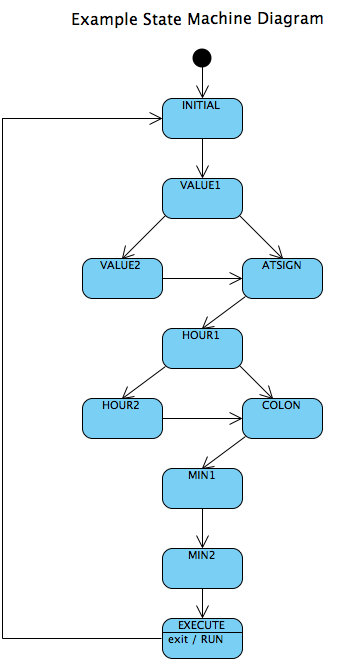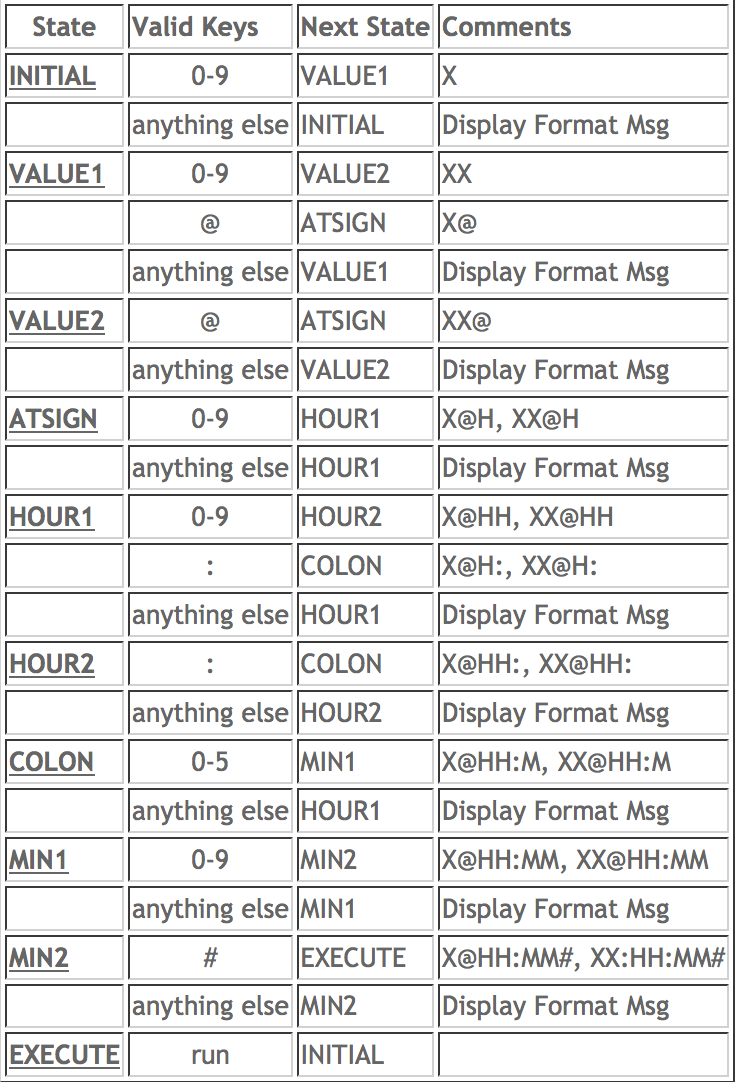The Problem:
You have a project that accepts commands using a 16 button keypad and want to perform validation on the commands as each character is typed. But how?
Example:

Here is the protocol (commands) using only a 4 x 4 - 16 button keypad:
XX@HH:MM#
Where:
XX is a value from 1-99
HH:MM is a time format (24 hr clock or military time)
Alpha-Numeric Key Mappings:
A = @ (at sign)
B = NOT USED
D = NOT USED
C = Clear
* = : (colon)
# = Execute (accept or enter or execute) the command
The Solution:
Use state machine logic / programming to solve the problem.
Introduction to State Machine Logic / Programming
If you aren't familiar with or haven't used state machine logic in programming, it is the easiest way to to break complex problems into manageable states and state transitions especially for handling serial input.
One of the easiest ways to implement a state machine is to use a switch statement. In my opinion it is the only way to implement serial input commands.
Example of a state machine using a switch statement:
switch(state) {
case INITIAL:
// process INITIAL state
break;
case STATE1:
// process STATE1 state
break;
case CLEAR:
clearAll();
state = INITIAL;
break;
default:
break;
} Let's now apply this logic to your project.
Here is a step by step approach to solve the problem:
- Break the commands into states.
- The easiest way is to consider each character in the command as a state.
- Given the command: XX@HH:MM#
- Here are suggested state names:
- VALUE1 - First digit of value
- VALUE2 - Second digit of value
- ATSIGN - At sign (@)
- HOUR1 - First digit of hour
- HOUR2 - Second digit of hour
- COLON - Colon (:)
- MIN1 - First digit of minute
- MIN2 - Second digit of minute
- EXECUTE - Pound sign (#)
- Then create an additional state called INITIAL
- Here are suggested state names:
- Create a list or table of all the combinations within a command or commands.
- Given the command: XX@HH:MM#
- All combinations of the command:
- XX@HH:MM# (45@12:45#)
- XX@HH:MM# (45@1:26#)
- X@HH:MM# (9@12:45#)
- X@H:MM#(9@1:26#)
- All combinations of the command:
- Given the command: XX@HH:MM#
- Determine all ranges for values
- XX has a range 1 to 99 but 01-09 is also valid
- HH has a range of 0-24 but 00-09 is also valid
- MM has a range of 00-59
- Create a state diagram.
- Start with a table or spreadsheet with all the states entered:
![]()
- For each state determine what keys are valid and the next state.
- INITIAL is the first digit of the value so valid keys are 0-9
- VALUE1 can be the second digit of the value or the at sign (@)
- Continue until you have completed all the valid key and next state.
![]()
- Here is an example of a state diagram in diagram format:
- Start with a table or spreadsheet with all the states entered:

- Next create the program
- Create #defines for each state
- Create a switch statement with each state as a case.
// States #define INITIAL 1 #define VALUE1 2 #define VALUE2 3 #define ATSIGN 4 #define HOUR1 5 #define HOUR2 6 #define COLON 7 #define MIN1 8 #define MIN2 9 #define EXECUTE 10 switch(state) { case INITIAL: break; case VALUE1: break; case VALUE2: break; case ATSIGN: break; case HOUR1: break; case HOUR2: break; case COLON: break; case MIN1: break; case MIN2: break; case EXECUTE: break; default: break; }
- Next create the some helper functions
- Create functions to validate input keys
// Validate keys: @ (at sign) // return true if valid, else false int validAtSign(int key) { int valid=0; switch(key) { case '@': valid=1; break; } return valid; } // Validate keys: : (colon) // return true if valid, else false int validColon(int key) { int valid=0; switch(key) { case ':': valid=1; break; } return valid; } // Validate keys: # (pound sign) // return true if valid, else false int validPoundSign(int key) { int valid=0; switch(key) { case '#': valid=1; break; } return valid; } // Validate keys: 0-9 // return true if valid, else false int validKeys0to9(int key) { int valid=0; switch(key) { case '0': case '1': case '2': case '3': case '4': case '5': case '6': case '7': case '8': case '9': valid=1; break; } return valid; } // Validate keys: 0-5 // return true if valid, else false int validKeys0to5(int key) { int valid=0; switch(key) { case '0': case '1': case '2': case '3': case '4': case '5': valid=1; break; } return valid; }
- Create functions to validate input keys
- Add the helper functions and minimal logic to the switch statements (states)
- Go state by state following the state diagram rules above
switch(state) { case INITIAL: // X if(validKeys0to9(key)) { pos = displayKey(key, pos); storeKey(key); state = VALUE1; } else { invalidFormat(); } break; case VALUE1: // XX if(validKeys0to9(key)) { pos = displayKey(key, pos); storeKey(key); state = VALUE2; } else if (validAtSign(key)) { // X@ pos = displayKey(key, pos); state = ATSIGN; } else { invalidFormat(); } break; case VALUE2: // XX@ if(validAtSign(key)) { pos = displayKey(key, pos); storeKey(key); state = ATSIGN; } else { invalidFormat(); } break; case ATSIGN: // X@H, HH@H if(validKeys0to9(key)) { pos = displayKey(key, pos); storeKey(key); state = HOUR1; } else { invalidFormat(); } break; case HOUR1: // X@HH, XX@HH if(validKeys0to9(key)) { pos = displayKey(key, pos); storeKey(key); state = HOUR2; } else if (validColon(key)) { // X@HH:, XX@H: pos = displayKey(key, pos); state = COLON; } else { invalidFormat(); } break; case HOUR2: // X@HH:, XX@HH: if (validColon(key)) { // X@HH:, XX@H: pos = displayKey(key, pos); state = COLON; } else { invalidFormat(); } break; case COLON: // X@HH:M, XX@HH:M if(validKeys0to5(key)) { pos = displayKey(key, pos); storeKey(key); state = MIN1; } else { invalidFormat(); } break; case MIN1: // X@HH:MM, XX@HH:MM if(validKeys0to9(key)) { pos = displayKey(key, pos); storeKey(key); state = MIN2; } else { invalidFormat(); } break; case MIN2: // X@HH:MM#, XX@HH:MM# if(validPoundSign(key)) { pos = displayKey(key, pos); storeKey(key); state = EXECUTE; } else { invalidFormat(); } break; case CLEAR: clearAll(); break; default: break; } // switch
- Go state by state following the state diagram rules above
- Test the results
- Add any additional limit/range checking on values.
- For example: valid time format is 00:00 to 24:00
- See example code. It utilizes the serial terminate and some helper functions for debugging.
- Add any additional limit/range checking on values.
It's as simple as that!
Source Code:
The complete working example is available here.
Working Demo:
Watch my video here
Future Enhancements / Ideas:
- The working example is meant as a teaching tool and doesn't have full validation on the values.
- This example does include code to use the serial terminal to help you debug.
Questions?
If you have any questions please feel free to ask.
I hope this article is helpful and useful to someone interested in
validating keypad input using state machine programming. Feel free to
use this code and example to validate you next project using a keypad
for input command.
The original blog appeared here.
Thanks,
Tony
 Tony Keith
Tony Keith
